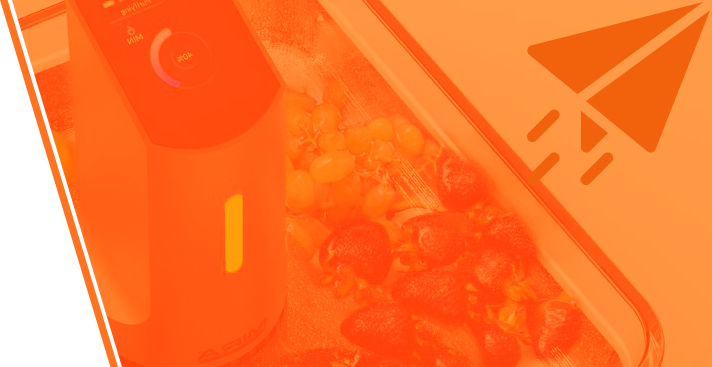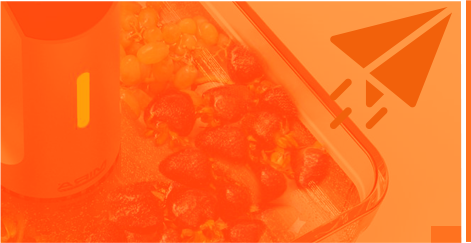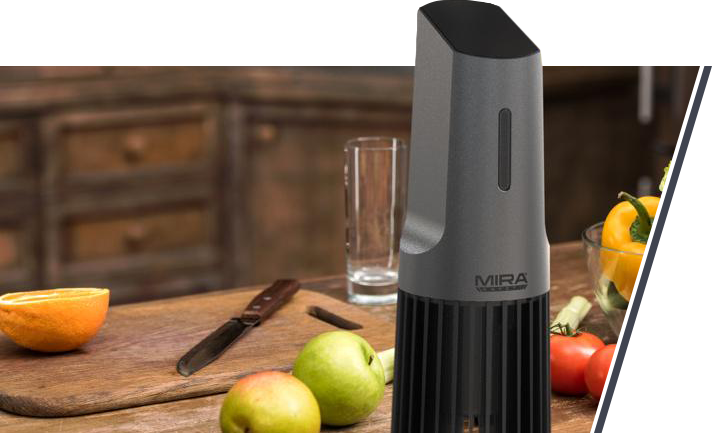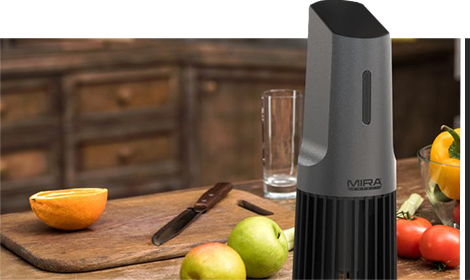We live in a world that is constantly changing.
Ever since the pandemic of 2020, a focus on health has been at the forefront of our minds. But long before COVID-19, there have been threats to our health and safety in the food we eat. One such threat is salmonella, a bacterium that has been causing human illness for over a century.
Salmonella can be found in various foods, including raw or undercooked meat, poultry, and seafood, as well as in unpasteurized dairy products, eggs, and even fruits and vegetables. When these foods are not handled or cooked correctly, they can become contaminated with salmonella.

The Centers for Disease Control and Prevention (CDC) estimates that salmonella is responsible for approximately 1.35 million cases of foodborne illness each year in the United States alone. This equates to about 15,000 hospitalizations and 420 deaths annually. While anyone can become infected with salmonella, specific populations are at higher risk, including young children, the elderly, and those with weakened immune systems.
In recent years, several high-profile salmonella outbreaks have been linked to various foods, including eggs, peanut butter, and even pet food. These outbreaks serve as a reminder of the importance of food safety and the need for effective strategies to prevent and control the spread of salmonella and other foodborne pathogens.
In this article, we will explore the topic of food safety as it relates to salmonella. We will discuss how this bacterium is spread, which foods are most commonly affected, and what steps you can take to reduce your risk of infection. We will also introduce the MIRA Safety DTX-1 Ultrasonic Food Cleanser, a tool for improving food safety in your home. By understanding the risks associated with salmonella and taking proactive measures to prevent infection, we can all work toward a safer and healthier future.
TABLE OF CONTENTS
-
01
Salmon the Savior?
-
02
Telling the Truth from Myth
-
03
Learning from the Past
-
04
Safety in Your Hands
-
05
Conclusion
Salmon the Savior
The discovery of salmonella in 1885 marked a turning point in the history of food safety. Salmonella was first identified in pigs suffering from a disease known as hog cholera, and subsequent research found that the bacterium could cause illness in various animals, including humans. We know this now thanks to the surprising efforts of one man.
Daniel Elmer Salmon was an American veterinary pathologist and bacteriologist best known for discovering the bacterium. Born in 1850 in Mount Olive, New Jersey, Salmon attended Cornell University, where he studied veterinary medicine to the best of his ability. After graduation, he worked as a veterinarian in New York and New Jersey before joining the newly established Bureau of Animal Industry in 1884, replacing the short-lived Veterinary Division created by the Commissioner of Agriculture in 1883.

Just a year later, in 1885, while investigating an outbreak of hog cholera, Salmon observed a previously unknown bacterium that was causing the disease. Having discovered it, he took the honor of naming it after himself—thus, the bacteria we know today as salmonella. This discovery marked the first time a bacterium was identified as the cause of a specific disease, and Salmon's work helped establish the role of bacteria in infectious diseases.
Salmon's discovery of salmonella as the cause of a specific disease was groundbreaking in microbiology and public health. Before his discovery, the concept of germ theory was not widely accepted, and it was not known that specific microorganisms could cause particular diseases.
By isolating and characterizing the bacterium, he demonstrated that it was the causative agent of hog cholera. This discovery not only helped control the spread of the disease in pigs but also paved the way for identifying other bacterial pathogens that cause disease in humans and animals.

The discovery of salmonella as a bacterial pathogen was a significant step in public health. It led to improved sanitation practices, the development of vaccines, and the ability to diagnose and treat infections caused by salmonella. Salmonella is now recognized as one of the most common causes of foodborne illness worldwide, and Salmon's work has had a lasting impact on microbiology and public health.
Salmon's discovery of salmonella as the cause of a specific disease was instrumental in advancing our understanding of microbiology. It paved the way for the development of effective control measures, and its impact is still felt today in the ongoing fight against bacterial pathogens.
Salmon's contribution to public health did not end with his discovery of salmonella, however. He also developed the first biological vaccine for anthrax, a significant breakthrough in preventing the disease. In addition, he played a vital role in developing the meat inspection system in the United States, which aimed to ensure that meat products were safe for human consumption.
Salmon's legacy continues to this day. His work paved the way for developing preventive measures against foodborne illnesses caused by salmonella and other pathogens.
Telling the Truth from Myth
Unfortunately, many myths and misconceptions about this dangerous bacterium can lead to harmful practices and unnecessary risks. Below we separate some of the worst misconceptions from the truth and help you stay safe.
Myth #1: Salmonella only comes from undercooked chicken.
While undercooked chicken is a common source of salmonella, this bacterium can also be found in many other foods, including eggs, dairy products, fruits, and vegetables. It can also be spread by contaminated utensils, cutting boards, and other kitchen surfaces. The bottom line is that most bacteria aren't too concerned about where they end up, just whether or not they'll be able to thrive.

Myth #2: You can tell if food is contaminated with salmonella by its smell or appearance.
Unfortunately, salmonella has no distinct smell or appearance, so you cannot tell if food is contaminated by looking at or smelling it. The only way to be sure is to cook food thoroughly and follow safe food handling practices.
Myth #3: Only young children and the elderly are at risk for salmonella.
While young children and the elderly are more vulnerable to the effects of salmonella, anyone can get sick from this bacterium. Healthy adults can also experience severe and sometimes life-threatening symptoms. It all comes down to the individual, and nobody is immune to the effects of harmful bacteria.

Myth #4: Washing fruits and vegetables with water is enough to remove salmonella.
While washing fruits and vegetables with water can help remove dirt and other contaminants, it is not enough to remove salmonella. The only way to kill salmonella on produce is to cook it thoroughly or use a food cleanser such as the MIRA Safety DTX-1 Ultrasonic Food Cleanser.
Myth #5: You can't get salmonella from packaged foods.
Packaged foods can be contaminated with salmonella. There have been many recent cases of salmonella outbreaks linked to packaged foods like nuts and dried fruits, so it's important to always check for any recalls or warnings issued by the Food and Drug Administration (FDA) or USDA.
It is crucial to separate fact from fiction when it comes to salmonella. Understanding the risks and taking appropriate precautions can protect yourself and your loved ones from this dangerous bacterium.
Learning from the Past
Salmonella outbreaks in the early 20th century became more common, particularly in the United States and Europe. One of the most notable outbreaks occurred in 1919 in Chicago, where nearly 10,000 people became ill, and over 100 died after consuming contaminated milk.

As knowledge of salmonella and other foodborne pathogens grew, efforts to prevent and control their propagation became more widespread. In the United States, the FDA was established in 1930 to regulate the safety of food and drugs. The CDC was created in 1946 to monitor and investigate outbreaks of infectious diseases.
Throughout the 20th century, technological advances and scientific research led to new methods for detecting and controlling salmonella. Pasteurization, for example, became a widely used process for treating milk and other dairy products to kill harmful bacteria, including salmonella. In addition, new methods for testing food for salmonella and other pathogens were developed, such as the polymerase chain reaction (PCR) and enzyme-linked immunosorbent assay (ELISA).
In 2008, an outbreak of salmonella was traced to a famous brand of peanut butter. The outbreak resulted in hundreds of reported illnesses across 46 states in the United States, and it ultimately caused several deaths. The peanut butter was produced by the Peanut Corporation of America (PCA), a now-defunct company that was once one of the world's largest producers of peanut products.

The investigation into the salmonella outbreak was complicated because the PCA sold its products to various businesses, including major food manufacturers and small independent stores. As a result, it was difficult to track the exact source of the contaminated peanut butter. However, after months of investigation, the FDA eventually traced the outbreak to a PCA plant in Blakely, Georgia.
The plant violated numerous health and safety regulations, including unsanitary conditions, contaminated equipment, and inadequate testing procedures. The FDA issued a recall of all PCA products, and the company declared bankruptcy shortly after that.
The salmonella outbreak caused great public outrage and sparked widespread concern about food safety in the United States. Many people were shocked to learn that a product as fundamental and ubiquitous as peanut butter could be contaminated with a deadly bacterium. In response to the outbreak, the FDA implemented several new regulations to improve food safety, including more rigorous inspections and testing requirements for food producers.

Despite the devastating impact of the salmonella outbreak, there were a few bright spots. The investigation into the episode was a model of interagency cooperation, as federal, state, and local officials worked together to track down the source of the contamination. In addition, the outbreak prompted a renewed focus on food safety and raised public awareness about the importance of proper food handling and preparation.
Today, the peanut butter industry is much safer than in 2008. Thanks to new regulations and more rigorous testing procedures, consumers can feel confident that their peanut butter is free from harmful contaminants. However, the outbreak serves as a reminder that food safety is an ongoing concern and must remain vigilant to prevent future foodborne illness outbreaks.
Safety in Your Hands
In recent years, the global food industry has faced many high-profile salmonella outbreaks and other foodborne illnesses. These outbreaks have highlighted the ongoing need for vigilance and proactive measures to prevent and control the spread of these pathogens.
Here are some tips for individuals to take safety into their own hands and protect themselves from salmonella:
1. Cook meat and poultry thoroughly. Make sure to cook meat and poultry thoroughly to kill any salmonella bacteria that may be present. Use a meat thermometer to ensure the internal temperature reaches a safe level.
2. Clean hands and surfaces. Wash your hands with soap and warm water for at least 20 seconds before and after handling food, especially raw meat, poultry, and eggs. Also, wash cutting boards, utensils, and countertops with hot, soapy water after each use.
3. Use pasteurized eggs. Salmonella can be present in raw eggs and can cause illness if not cooked properly. According to the USDA, "All egg products are pasteurized as required by the United States Department of Agriculture's (USDA) Food Safety and Inspection Service (FSIS). This means they have been rapidly heated and held at a minimum required temperature for a specified time to destroy bacteria."
4. Keep food at safe temperatures. Keep hot foods hot (above 140°F) and cold foods cold (below 40°F) to prevent the growth of bacteria.
5. Avoid cross-contamination. To avoid cross-contamination, keep raw meat, poultry, and eggs separate from ready-to-eat foods. This means using different cutting boards, utensils, and storage containers for raw and cooked foods.

6. Be mindful of high-risk foods. Be extra careful when handling high-risk foods, such as raw or undercooked meats, poultry, seafood, raw sprouts, unpasteurized milk, and cheese made from raw milk.
7. Be cautious when eating out. When eating out, be careful of food that may have been undercooked or improperly handled. Ask for your food to be cooked thoroughly and for any sauces or condiments to be served on the side.
Consider using an ultrasonic food cleanser. The MIRA Safety DTX-1 Ultrasonic Food Cleanser can detoxify and cleanse produce and other food items from harmful contaminants, including salmonella, and help prevent the spread of foodborne illness.

These simple tips can significantly reduce the risk of you or your family contracting salmonella and other foodborne illnesses.
Technology and innovative tools, such as the MIRA Safety Detoxifier Food Cleanser, can help reduce the risk of salmonella contamination in the home and commercial settings.
The MIRA Safety Detoxifier is designed to cleanse food using a combination of ultrasonic waves and rapid oxidation to release and dissolve toxins. With a user-friendly touchscreen display and multiple cleaning modes, the DTX-1 is the perfect tool for detoxifying raw foods, thermal treatment, antiparasitic treatment, and detoxification of household items such as keys and jewelry.
Unlike other detoxifiers, the DTX-1 uses zero chemicals, solvents, cleaning agents, or additives. Once activated, the unit uses a high-power ultrasonic generator to remove contaminants on the surface of foods or suspended in drinking water. The device rapidly saturates the water with active oxygen molecules to completely penetrate the food product, oxidizing pesticides and other harmful compounds.

The DTX-1 is built to last with durable construction designed for maximum rapid cleansing. Tested for effectiveness and approved by laboratories in Switzerland and the European Union, this simple and easy process can be performed daily, ensuring the safety and health of you and your loved ones. Plug the unit into a 120V AC wall outlet and enjoy peace of mind knowing your food and water are free from harmful contaminants. Get your MIRA Safety DTX-1 Ultrasonic Food Cleanser today and take control of your food safety!
Despite the progress made in understanding and preventing salmonella over the past century, this bacterium continues to pose a significant public health threat. We can work toward a safer and healthier future by staying informed about the risks associated with salmonella and taking steps to protect ourselves and our families.
Conclusion
Salmonella is a severe and common foodborne illness that affects people worldwide, and it is responsible for thousands of hospitalizations and even deaths each year. While it is a complex illness to eradicate, there are many steps that people can take to reduce their risk of contracting it.
By practicing safe food handling and preparation techniques, being aware of the signs and symptoms of salmonella infection, and seeking medical attention when necessary, individuals can protect themselves and their families from the harmful effects of this illness. Additionally, the MIRA Safety DTX-1 Ultrasonic Food Cleanser provides a practical and chemical-free way to clean and detoxify food and water, helping further to reduce the risk of salmonella and other harmful contaminants.
It is vital to stay informed about the latest developments and news related to salmonella and other foodborne illnesses. With ongoing research and efforts to improve food safety, we can continue to progress in preventing and reducing the impact of these illnesses on our communities. By working together and taking proactive measures, we can help ensure a healthier and safer future for everyone.





